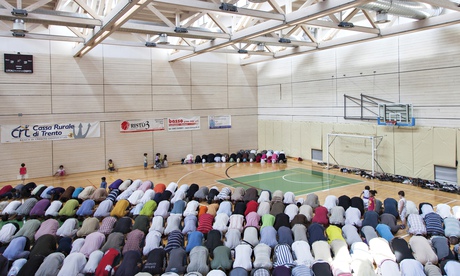
This year's author book award at the Rencontres d'Arles photography festival went to Nicolo Degiorgis for Hidden Islam. With a foreword by Martin Parr, the man who matters most in the world of the photobook, it arrived in Arles with buzz attached from the recent photobook festival at Bristol co-curated by Parr.
Hidden Islam looks at how and where Muslims worship in Italy, a country with an estimated 1.45 million believers but only eight official mosques. In the north of Italy, where Degiorgis comes from, the rightwing party, Lega Nord, has risen in popularity lately due to its hard line on immigration and anti-Islamic views.
In Treviso, where local worshippers purchased a building, they have been prevented by the local authority from turning it into a mosque despite the right to worship being freely enshrined in Italian law. They gather weekly to lay down their prayer mats in front of the building – prayer as a kind of protest. It is against this increasingly polarised political and social backdrop, that Muslims have begun worshipping in makeshift buildings across the country. This is the subject of Degiorgis's book: the often anonymous buildings that now have a kind of secret life.
Like Lorenzo Vittori, Degiorgis is a graduate of the Benetton-funded Fabrica centre in Treviso, and, design-wise, his is a clever book. The cover image is a map of north-east Italy with a small, boxed index below listing the various buildings that now have a second life as places of worship: warehouses, garages, gyms, shops and even a disco. Inside, photographs of these often drab exteriors are contrasted with the vibrantly colourful images of the interiors. Sometimes, they are full of people, sometimes just one or two worshippers are engaged in silent prayer.
Degiorgis often shoots from above, giving us an elevated view of prone bodies in a huge gym, or a vista that takes in an assortment of shows outside the door of a room as well as the worshippers within. In one intimate image, he captures a small group of people curled up sleeping on woven rugs. In another, rows of men kneel, their foreheads on the floor, in a kind of secret garden fenced off by swathes of cloth and layered with woven fabrics.
Hidden Islam is an evocative, multi-layered book that contrasts the reverent peacefulness of these makeshift places with the often tense politics that surrounds them. Neither reportage nor concerned documentary. it allows the viewer to delve into the images and their layers of meaning – social, religious and political. The Italy that emerges is an intolerant one in which the right to worship freely and live without fear of discrimination seems to have already been eroded.
In his documentation of this furtive Islam, Degiorgis has also highlighted the ways in which a community under siege becomes resilient and collectively defiant in the face of creeping oppression. A quietly powerful book that attests to the power of Degiorgis's quiet attentiveness.
• Hidden Islam is published by Rorhof (€47)

